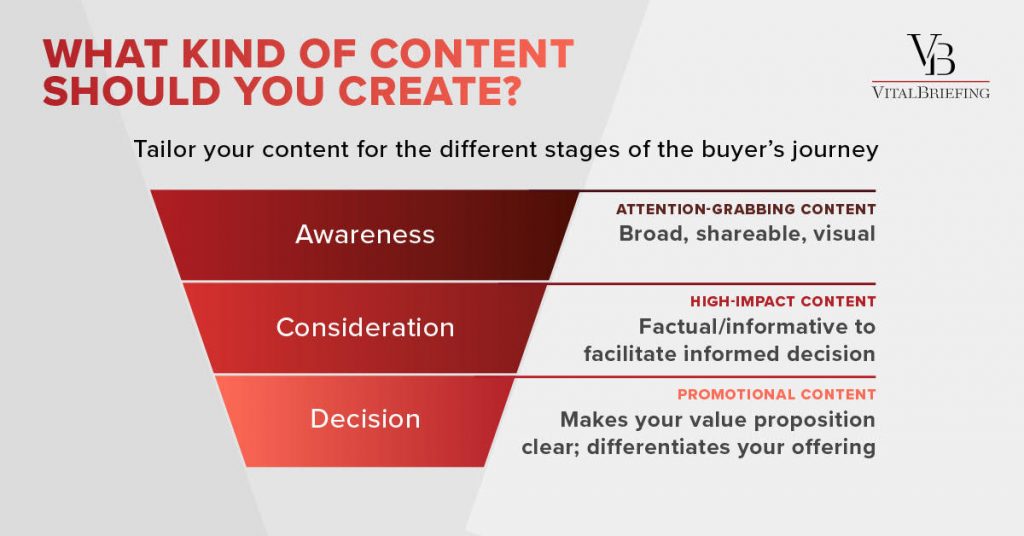Does your business need to create content marketing? More importantly, do you know how to produce effective, engaging and high-impact material for each stage of the buyer’s journey?
Welcome to the club. Content marketing is now must-have as companies across all industries accept that high-value content is the most effective way to attract clients and prospects.

As proud content geeks (i.e. content marketing specialists), we love seeing this sector rocket to the forefront of digital marketing. However, few organisations give much, if any, thought to the exact type of content they need.
We know because we talk to them all the time when discussing VitalBriefing’s content marketing services. While they acknowledge their need for content, they’re lost at sea, lacking the means to define, much less produce, quality content.
Even when they decide they should…well, frankly, they get it wrong. They go straight to the last step — create the content — rather than following the process that guarantees an effective content marketing funnel.
We’re going to walk you through that process so that you’ll know where to start, how to proceed and how to finish with the exact content that will bring you clients, prospects and new opportunities.
Here’s our first piece of advice: Don’t create content for content’s sake.
To help you avoid the trap that snares many companies, we need to start with a trip.
Connecting the buyer’s journey to your content marketing
There are three basic legs of the voyage your prospects take on their way to becoming your clients:
- Awareness
- Consideration
- Decision
First understand the concept and use of a buyer’s journey (AKA the customer journey) in your content production and we promise that your content will be successful. Want to draw more visitors to your website? Generate more qualified leads? Educate your customers so that they’ll appreciate your expertise?
Whatever the goal, the buyer’s journey should serve as the framework for the steps your audience takes on the way to a purchase: First, they identify the problem (awareness). Next, they do their research (considerations). And finally, they commit to buy the product or service that will solve their problem.
“When the buyer’s journey works in your favor, from the marketer’s perspective it’s helpful to view the buyer as progressing through the stages of knowing, then liking, then trusting your brand,” says Barry Feldman, writing for the Taboola blog.
Why is the buyer’s journey so important?
Almost every element of a digital marketing campaign reduces to a piece of content — text, graphic, sound, video, social media — you name it. Brands and companies are producing and publishing more than ever, while digital audiences are lapping it up as fast as it hits them.
Indeed, more than four of every five buyers conduct online research before making a purchase, according to data from eCommerce merchandising company MineWhat.
Moreover, B2B buyers view an average 14 pieces of content before buying from a vendor (up from five several years ago), while more than half view at least eight during their purchase process, according to market research firm Forrester.

Think about it. One individual stumbles on your website, article or video during an initial web search related to a need you can help fulfil. Another is farther on the customer journey and almost ready to buy, edging toward a decision between you or your competitors.
Brands should have content marketing tailored for each of the specific stages of that journey.
Now it’s time to plan accordingly.
Glue your content marketing plan to the buyer’s journey
You apply strategy to every other aspect of your business. It’s no different here: Start with a clear and dynamic content marketing strategy to ensure that what you produce lands at the right audience at the right time — and is appropriate specifically for them.
Here’s why: If people don’t relate to your content, they won’t consume it. You have literally seconds to grab them.
Before choosing the subjects to cover in that content, answer these questions:
- Who’s your target?
- Where are they in the buyer’s journey?
- What do you want them to do when they’re done?
Got answers to all three? You’re ready to get started. If not, we’ve got some work to do together first.
There’s an arc to the customer journey. “By looking at how people develop a relationship with your brand over time (commonly called the buyer’s journey), and determining what kinds of content are most helpful for people in each stage of their journey, you can anticipate what type of material you’ll need,” writes Ben Kulakofsky.
By linking a content strategy to pre-defined stages of your company’s buyer’s journey, you’ll develop the various types of content marketing that will connect with your desired audience at the most appropriate point in their customer journey, inspiring them to become customers.
Buyer’s journey: targeting the ‘Awareness’ stage
Ok, this stage is the easiest. It’s the top of the sales funnel. At this point in their journey, prospects:
- realise they have a problem – or opportunity;
- have initiated their research, searching for answers and solutions;
- prowling for resources, education, data, opinions and insight
At this stage, your content should focus on the buyer’s pain points, not on your company or offering. “They are still formulating the vocabulary around the issue that will help them search for a solution,” explains Kulakofsky.
Your single goal at this stage is brand awareness. To get there, you should prioritise keyword and search query targeting that your company’s prospects might use so that your company ranks at the top of those searches. It makes sense to improve your SERPs rankings: 70% of buyers use Google during the research phase, according to a study by Pardot.
Think about the best format and kind of content to reach your prospects in this stage. Could be a blog post. Or a white paper. Maybe an eBook and eGuide. Or images such as videos and infographics.
If you’re following the steps we’ve outlined so far, the answer will be apparent. Bottom line is that the content should create trust by being objective and educational, clearly articulating the problem or opportunity, contextualising it and outlining solutions.
Be guided by these key factors in your planning:
- Research the best keywords and long-tail search phrases to target;
- Ensure the content is high quality, easy to consume, original, well-researched and featuring credible references;
- Determine the best channels and platforms for its promotion — social media content marketing can be a game-changer in this stage;
- Bake in the next step for the prospect after consuming the content. Present a clear Call to Action (CTA). Have you made it obvious, logical and easy to perform? (Like? Subscribe? Call? Email? Buy?);
- Grab attention with content that’s seductive, visual and shareable.
Buyer’s journey: targeting the ‘Consideration’ stage
What happens once your prospects reach the middle of the funnel, closer to buying? Now you can call them leads. They’ve reached the ‘consideration’ or ‘evaluation’ stage, with a stronger understanding of their problem, deeper into the effort to solve their problem, researching potential solutions and evaluating their options.
Your task is to keep them moving on their journey.
This is arguably the most crucial moment of the three stages in the buyer’s journey. While not there yet, the lead is moving towards a decision regarding appropriate solutions. You need to nurture her or him.
“People in the middle of your sales funnel are likely to be looking to you for content showing that you’re the experts in your industry,” Hubspot points out in its blog. “That’s why the most effective types of content in the evaluation stage…compare your features and benefits with that of your competitor.”
The prospect has you squarely in mind now. While your content should maintain a level of objectivity, it should highlight the merits of your solution, team and brand.
Companies that get this stage right will vastly increase their chances for payoff at the end of the journey. Deliver refined and dynamic content now and you’ll generate middle-of-the-funnel engagement and lead management experience at a response rate four to ten times higher than generic e-mail blasts and outreach.
Here’s your list when planning content for the consideration stage:
- Make it easy via this content to collect contact details;
- Research the best keywords and long-tail search phrases for you to target at this stage. We recommend targeting long-tail phrases that have words such as service, product, tool, supplier, reviews, solutions, and pros and cons.
- Consider investing in ‘retargetting‘ with this content (for example, paying to get it delivered to specific prospects and groups).
- Create CTAs that clearly benefit the prospect, such as requesting a product demo, downloading solution-oriented material (white papers, eBooks, webinars), or offering a free trial.
Buyer’s journey: targeting the ‘Decision’ stage
You’ve brought the prospects to the end. Now they’ll make their choice and commit to buy.
“A lot of the hard work was done in the previous two stages,” says Isaac Justesen. “If you have done a good job of educating a prospect and presenting them with potential solutions in an engaging and respectful way, there’s a pretty good chance they’re going to strongly consider your company when it comes time to vote with their wallet.”
Your prospects are looking for any reason not to buy from you, so don’t give them one. Your content now should be focused on converting leads into sales. You need one more push to get them over the line. It’s time for a compelling CTA that convinces and/or inspires them to choose you.
A strong offer, together with the right type of content at this stage can substantially improve conversions. The content should be direct, with important information about your offering. It shows why you’re better than your competitors and showcases your value proposition.
That content can feature:
- Case studies;
- Product literature and demonstrations;
- Assessments;
- Estimate request buttons;
- Pricing tier information;
- Product tutorials;
- Downloads;
- Calls-to-action for trial offers and free product demos.
“By itself, a bottom-of-the-funnel offer isn’t likely to close a lot of leads into customers,” Hubspot argues. “However, when you have it mapped appropriately to the buyer journey, you’re combining the compelling nature of that final offer with all the engagement you’ve created leading up to that point.”
You’re nearly there. Get these factors in order, and you’re good to go:
- Optimise your website’s navigation, UX (user experience) and CTAs. These elements should drive prospects and leads to your bottom-of-the-funnel content.
- Ensure customer support is easy to reach from this content — this is crucial to closing the deal.
- Content here should resolve any lingering questions, concerns or reservations that could stand in the way of the decision you want.
Now you’re ready to create the right content marketing at the right time for the right audience. Go forth and grow your business.

